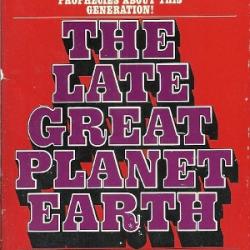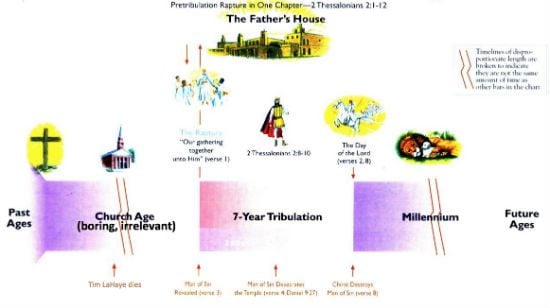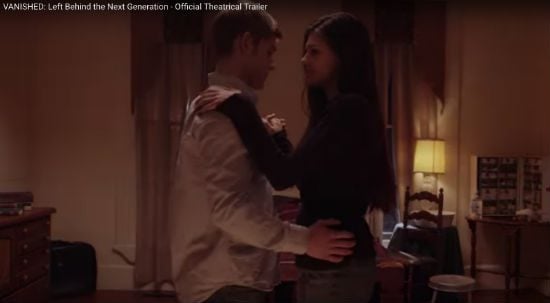Tribulation Force, pp. 307-310
I'm in a holiday spirit, so in keeping with the generosity of the season, peace on earth good will to all and all that, I'm going to try to accentuate the positive when looking at these pages from Tribulation Force. I think I've even managed to find some positive aspects of this section to highlight.
The first leaps out at us from the opening sentences of Chapter 14:
Buck Williams was cashing in all his journalistic chips. After trying to sleep off jet lag in the King David Hotel on Saturday, he had left messages for Chaim Rosenzweig, Marc Feinberg and even Peter Mathews. …
When we last saw Buck he was at the United Nations building in Manhattan, about to head back to Kennedy International Airport after spending most of Chapter 13 in a cab riding first to, then from, that airport. This circling about in New York City traffic did nothing to advance the plot of the book nor to develop any of its characters, yet Jerry Jenkins didn't seem to think it was worth skipping over, providing his readers a blow-by-blow account of all this commuting that was nearly as pleasurable as an actual drive to or from JFK.
We've previously discussed Jenkins' habitual violations of Kurt Vonnegut's "Eight Rules for Writing Fiction," particularly Vonnegut's Rule No. 4: "Every sentence must do one of two things — reveal character or advance the action." That rule is really just something of an elaboration of Vonnegut's first rule: "Use the time of a total stranger in such a way that he or she will not feel the time was wasted."
Jenkins flagrantly violated both of those rules in the previous chapter with all that time- and ink-wasting business of driving in circles in what seemed to be nothing more than shameless padding. The only rationale the authors seemed to offer for that dull and pointless chapter was Rabbi Feinberg's brief summary of the history of the temple. Yet even that was unnecessary, as here in Chapter 14 Buck is in Jerusalem and will soon visit the Temple Mount in person accompanied by the book's Grand Expositor, Tsion Ben-Judah. The character of Feinberg never needed to be introduced and neither Buck nor the readers needed to be dragged to and from the airport.*
But here at the beginning of Chapter 14 we see the first signs of Jenkins beginning to follow Rule No. 4. He has advanced the action by transporting Buck from New York to Jerusalem, where the next bit of action in our story is set to occur. And he did so without wasting readers' time with a blow-by-blow account of Buck's trip back to JFK, his walk through the terminal, the flight to Israel, etc. In extremely un-Jenkinslike fashion, Jenkins has skipped over the uneventful details of travel and cut to the chase.
Well, not quite to the chase. Buck awakens in Jerusalem and immediately starts in with the phone calls, including several pages of conversation with Steve Plank rehashing and repeating their earlier conversation about why Nicolae won't help Buck gain access to the Two Witnesses at the Western Wall. But despite this initial relapse into redundancy, and despite his layering on of multiple superfluous phone calls that should have happened off-stage, we begin to get a sense — finally, 300+ pages in — that some of these redundant passages at last have an actual purpose. Something is finally going to happen in this dismally uneventful book.
We're not quite there yet. There's plenty of padding and throat-clearing and repetition in the first half of this chapter, but by the end of Chapter 14, the authors will have introduced us to a major new character and he and Buck will have done something together.
The other positive point in these pages comes in the account of Rayford's first flight at the helm of the new Air Force/Global Community One.
Here again the authors seem far more excited about the shiny new plane than readers are likely to be, and Rayford Steele comes across as his usual insufferable self. Yet try to look past the annoying arrogance of the protagonist and the continuing portrayal of "Air Force One" as some kind of civilian charter jet and consider what we have here:
Rayford had met the crew of Global Community One just a couple of hours before takeoff. Not one had ever worked for Pan-Continental. In a brief pep talk he had emphasized that safety was paramount. "That is why every one of us is here. Proper procedure and protocol come next. We do everything by the book, and we keep our logs and checklists as we go. We look sharp, we stay in the background, we serve our hosts and passengers. While we are deferential to the dignitaries and serve them, their safety is our primary concern. The best airplane crew is an invisible one. People feel comfort and security when they see uniforms and service, not individuals."
Rayford's first officer was older than Rayford and probably had wanted the pilot's position. But he was friendly and efficient. The navigator was a young man Rayford would not have chosen, but he did his job. The cabin crew had worked together on Air Force One and seemed overly impressed with the new plane, but Rayford couldn't fault them for that. It was a technological marvel, but they would soon get used to it and take it for granted.
Flying the 757 was, as Rayford had commented to the certifying examiner in Dallas, like sitting behind the wheel of a Jaguar. But the excitement wore off as the flight stretched on. …
Yes, Rayford Steele is still the same pompous, condescending git we've come to know through the course of these books, and there are plenty of stylistic, technical and continuity flaws we could discuss in these pages. But it's Christmas, remember, holiday spirit, etc., so let's just focus on what I find praiseworthy in this passage.
Rayford Steele is a pilot and here we see him at work, doing his job. Set aside the realism or accuracy of that portrayal and just notice that this is what we are being shown.
That's an unfortunately rare thing in most stories not involving police officers, private detectives or doctors. Our work — the stuff we spend most of our waking hours doing — is rarely regarded as a part of our stories. Stories often treat this work the same way we often think of it — as time to be killed, time apart from life that doesn't really count as part of that life. Cause and effect flow in both directions here. Our stories treat work as though it were a separate thing that doesn't really count because that is how we think of it. And we think of it that way, in part, because this is how our stories treat it.
Rayford Steele is not an easy character to like. His regard for himself is so vast that it leaves little space or oxygen for readers to share in it, and so he comes across as a clownish Malvolio. (A violation of Vonnegut's Rule No. 2: "Give the reader at least one character he or she can root for.") But here is something genuinely admirable about the guy: He takes his work seriously and he wants to do it well.
Rayford believes that being a good person requires being good at one's craft. That's almost right. I'd amend it to saying that becoming a better person requires becoming better at one's craft — a distinction that helps avoid the pitfall both Rayford and Buck seem to have fallen into of becoming so arrogantly self-assured that one stops learning, practicing and refining, assuming that one already knows all there is to know and that one is already as good as one can be. But still, he's got that initial, prerequisite commitment to his work and his craft.
If only Tim LaHaye and Jerry Jenkins shared such a commitment then these books might be —
But it's Christmas. We'll save that for another time.
– – – – – – – – – – – –
* What I found least believable in Chapter 13 was Buck's willingness to ride both ways in the cab without getting into a discussion with the driver as to the best or proper way to get from midtown to JFK. Guys like Buck are never, ever indifferent on the question of How to Get to the Airport. They are certain that they have figured out the best, fastest, most hassle-free secret route and they will not be stopped from explaining to you that there are two types of people when it comes to trips to the airport: 1) Those who gratefully take his advice, and 2) Foolish suckers who insubordinately insist on taking some other route.
That Buck didn't take the time to lecture both Feinberg and the cabbie on the gnostic mystery of How to Get to the Airport seemed weirdly out of character. It was as jarringly inconceivable to me as being told, say, that Rayford Steele doesn't wear expensive cologne.












